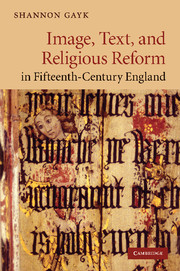Book contents
- Frontmatter
- Contents
- Acknowledgements
- List of abbreviations
- Introduction: reformations of the image
- 1 Lollard iconographies
- 2 Thomas Hoccleve's spectacles
- 3 John Lydgate's refigurations of the image
- 4 John Capgrave's material memorials
- 5 Reginald Pecock's libri laicorum
- Epilogue: words for images
- Notes
- Bibliography
- Index
- CAMBRIDGE STUDIES IN MEDIEVAL LITERATURE
1 - Lollard iconographies
Published online by Cambridge University Press: 17 November 2010
- Frontmatter
- Contents
- Acknowledgements
- List of abbreviations
- Introduction: reformations of the image
- 1 Lollard iconographies
- 2 Thomas Hoccleve's spectacles
- 3 John Lydgate's refigurations of the image
- 4 John Capgrave's material memorials
- 5 Reginald Pecock's libri laicorum
- Epilogue: words for images
- Notes
- Bibliography
- Index
- CAMBRIDGE STUDIES IN MEDIEVAL LITERATURE
Summary
An ethical fairness which requires “a symmetry of everyone's relation” will be greatly assisted by an aesthetic fairness that creates in all participants a state of delight in their own lateralness.
Elaine Scarry, On Beauty and Being Just[T]ruþe þat wolde make many blynde to se if it were yknowe is þis: þat God is nowher fair serued, saue þere þat his lawe is fair kept.
The Lollard sermon, Omnis plantacioJohn Wyclif's quite conventional assertion that images “may be made both well and ill” apparently did not articulate a strong enough case against visual media for many of his fifteenth-century followers. Indeed, it is often noted that one of the most consistent features of Lollard texts is the critique and rejection of devotional images. Yet while many Lollard writers equated image veneration with idolatry and advocated the replacement of visual libri laicorum with textual ones, as this chapter will show, other Lollard writers represented the visual in more measured terms and used vernacular texts to help readers learn to distinguish between “false” and “true” images and, more broadly, between misleading representations and edifying ones. A set of moderate Lollard sermons, for example, draws out these distinctions by means of imaginative antitheses. In the Christmas sermon, the preacher asks his listeners to imagine the Nativity scene by posing a series of questions:
Wher weren þe grete castellis and hye toures, wiþ large halles and longe chaumbres realli diȝt wiþ doseris, costeris, and costious beddes, and corteynes of gold and selk, able to þe birþ of so hiȝ an emperoure? […]
- Type
- Chapter
- Information
- Publisher: Cambridge University PressPrint publication year: 2010

